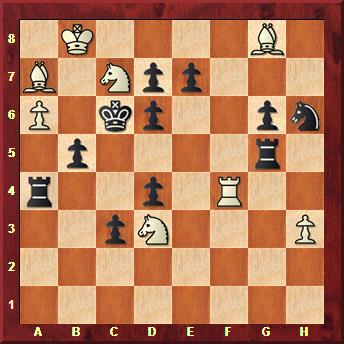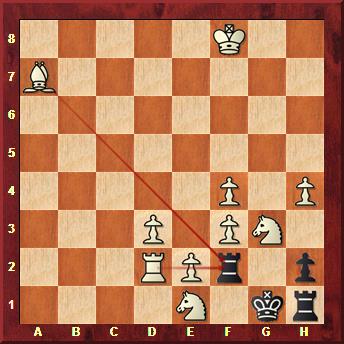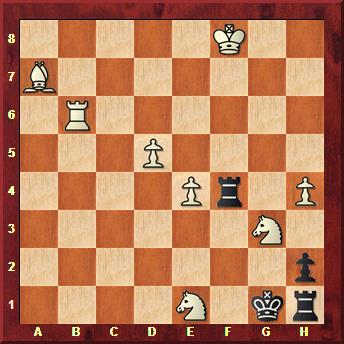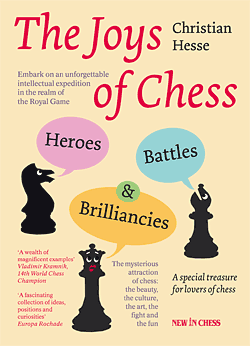Threats of the nth degree
By Prof. Christian Hesse
The success of a threat or of a counter-measure is based almost exclusively
on a correct evaluation of the other person’s concept of reality.
That means on my correct estimation of what he will do about it, because
he works out what I might do about it, because I have considered... etc.
– Paul Watzlawick: Wie wirklich ist die Wirklichkeit (How real
is real?)
We humans can in principle soar to rather complex degrees: I assume
that you are wondering if I realise how difficult it is for you to be
sure that you understand if I intend to say that you could recognise that
I believe you would like me to explain that most of us can only manage
as far as the fifth or sixth step. – Daniel Dennett: Intentional
Systems
There are moves which directly and bluntly threaten to bring about a concrete
threat – perhaps mate or the win of material. In his book Chess
tactics for advanced players Averbakh described these as threats of
the 1st degree. 2nd degree threats are moves which are intended to enable
threats of the 1st degree. And so it continues recursively. Threats of the
3rd degree are those moves which are intended to enable threats of the 2nd
degree, etc.
As a simple primer, let us enjoy the following position, which is the
starting point for threats of various degrees. It is a snapshot from the
game B. Katalymov-E. Mnatsakanian, USSR 1959:

From a purely visual point of view, Black’s king appears to be in
some sort of danger. But White has to transform this instinctive feeling
into a tangible plan. There exists in 1.Qf8+ a simple threat of the 1st
degree. But the f6 rook is protecting the square on the back rank and thus
preventing this check. The threat of the 2nd degree consists of 1.Bh6 and
carrying it out activates the threat of the 1st degree, because after ...Rxh6
the f8-square is no longer under the surveillance of the rook.
But the 1st degree threat is not yet convincing, because Black has in
his hands the defence ...Bg8, which will prevent it being carried out. A
further enhancement is required: a threat of the 3rd degree, which is the
now decisive 1.Rd7!! Carrying it out makes possible the
carrying out of the threat of the 2nd degree, which in its turn enables
the threat of the 1st degree and finally wins the game: 1...Bxd7,
and the bishop can no longer interpose itself on g8. Then comes 2.Bh6!!,
which makes the threat of the first degree playable, since either 2...Rxh6
3.Qf8# or 2...gxh6 3.Qxf6+ Kg8 4.Qf7+ Kh8 5.Qf8# must happen. 1-0.
A combination with a preface. And with a preface to the preface.

[Event "USSR"] [Site "?"] [Date "1958.??.??"] [Round "?"] [White "Katalymov,
B."] [Black "Mnatsakanian, E."] [Result "1-0"] [SetUp "1"] [FEN "1rq1B2k/2p1Q1pp/pb2br2/5p2/5B2/6P1/5P1P/3RR1K1
w - - 0 1"] [PlyCount "5"] [EventDate "1958.??.??"] [SourceDate "2016.02.05"]
1. Rd7 $3 Bxd7 2. Bh6 $3 Rxh6 (2... gxh6 3. Qxf6+ Kg8 4. Qf7+ Kh8 5. Qf8#)
3. Qf8# 1-0
Let us now turn to the realms of chess art.
S. Eisert & H. Rehm, 1995

White to move and mate in 6 moves
This problem has as a pretty motif a threat of the 3rd degree.
The primary threat consists of 1.Nxd5, which, when combined with 2.Nxe7#
or with 2.N3b4+ Rxb4 3.Nxb4# would in each case force mate. 1...Rxd5 cannot
serve as a defence, since 2.Rf8 and 3.Rc8# lead to mate. But 1.Nxd5 fails
to 1...b4!. The secondary threat seeks to prevent this with the knight sacrifice
1.Nb4+, but after 1...Rxb4 the main threat 2.Nxd5? is now refuted by 2...Re4!.
So to get rid of this new obstacle, a threat of the third degree is required,
to first of all push away the influential black rook: 1.h3!! Ra4
2.Rf4 d4, and we have reached the following position:

And White has achieved his goal of the 3rd degree. Now the threats involved
in degrees 1 and 2 can take effect according to plan: 3.Nb4+ Rxb4
4.Nd5 Rxd5 5.Rf8 and then 6.Rc8#.

[Event "?"] [Site "?"] [Date "1995.??.??"] [Round "?"] [White "Eisert/Rehm,
S/H."] [Black "Mate in six"] [Result "1-0"] [SetUp "1"] [FEN "1K4B1/B1Npp3/P1kp2pn/1p1p2r1/6r1/2pN4/5R1P/8
w - - 0 1"] [PlyCount "11"] [EventDate "1995.??.??"] [SourceDate "2016.02.05"]
1. h3 $3 (1. Nxd5 b4 $1 (1... Rxd5 2. Nb4+ (2. Rf8 b4) 2... Rxb4 3. Rf8
Nxg8 4. Rc8#)) (1. Nb4+ Rxb4 2. Nxd5 Re4 $1) 1... Ra4 2. Rf4 d4 3. Nb4+
Rxb4 4. Nd5 Rxd5 5. Rf8 Nxg8 6. Rc8# 1-0
Our next position shows an artistically orchestrated masterpiece in which
White, in order to meet continually fresh obstacles, has to find more and
more threats, going as far as the 5th degree:
H. Grasemann, 1961

White to move and mate in 11 moves
The main threat 1.Bxf2# is quite obviously blocked by the pawn on e2. If
the latter moves away with 1.e4?? (2nd degree threat), the result is a common-or-garden
stalemate. So a threat of the 3rd degree is needed: 1.e3!? could be considered
and after 1...Re2 the planned 2.e4+ Rf2 3.Bxf2# would follow. But unfortunately
after 1.e3!? the prosaic 1...Rxd2 provides Black with another defence. White
gets rid of this counter by arranging (4th degree threat) for the white
rook to first move away and then come back, while keeping a close eye on
possible moves for Black so as to avoid stalemate. This works along the
following lines: 1.d4!! Rg2 2.d5+ Rf2 3.Rd4 Rg2 4.Rc4+ Rf2. And now the
variation 5.e3 Rg2 6.e4+ takes into account all the defensive lines which
have so far appeared for Black and White mates with 6...Rf2 7.Rd4 Rg2 8.Rd2+
Rf2 9.Bxf2#.
But once more there is an obstacle for White in the series of exchanges:
after 5.e3 Black does not only have at his disposal the move 5...Ra2!, which
means that 6.e4+ no longer works, but he also has 5...Rxf3! and then 6.e4+
Rf2 7.Rd4 Rxf4+. So White requires an even more deeply hidden move generating
a two-pronged threat (a threat of the 5th degree), which takes into account
these latest two complications and at the same time nullifies both of Black’s
resources. That is achieved by 4.Rb4+ (instead of 4.Rc4+?).

This maps out the further course of events: 4...Rf2 5.Rb6! Rg2 6.Ra6+!.
This liquidates one of the two defensive lines. 6...Rf2 7.e3 Rxf3 8.e4+
Rf2 9.Rb6 Rxf4+.

Now 10.Rf6+ can neutralise the other of Black’s two defensive possibilities.
Mate is in sight.
To sum up we have the following main line: 1.d4!! Rg2 2.d5+ Rf2
3.Rd4 Rg2 4.Rb4+ Rf2 5.Rb6 Rg2 6.Ra6+ Rf2 7.e3 Rxf3 8.e4+ Rf2 9.Rb6 Rxf4+
10.Rf6+ Rf2 11.Bxf2#, and that’s that!
Elegant to the very end, complex and positively breathtaking. A web of
intricate rook manœuvres which is marked by white threats, black parries,
white counter-threats, black ripostes to the counter-threats, etc., until
the f4-rook, which has to shoulder all the defensive work in this chain
of cause and effect, finally runs out of breath. But in the final analysis,
it is the latter’s king who has to pay the price.

[Event "?"] [Site "?"] [Date "1961.??.??"] [Round "?"] [White "Grasemann,
H."] [Black "Mate in 11"] [Result "*"] [SetUp "1"] [FEN "5K2/B7/8/8/5P1P/3P1PN1/3RPr1p/4N1kr
w - - 0 1"] [PlyCount "21"] [EventDate "1961.??.??"] [SourceDate "2016.02.05"]
1. d4 $3 (1. e4 $4 {stalemate.}) (1. e3 $5 Rxd2 (1... Re2 2. e4+ Rf2 3.
Bxf2#)) 1... Rg2 2. d5+ Rf2 3. Rd4 Rg2 4. Rb4+ (4. Rc4+ Rf2 5. e3 Ra2
$1 (5... Rg2 6. e4+ Rf2 7. Rd4 Rg2 8. Rd2+ Rf2 9. Bxf2#) (5... Rxf3 6.
e4+ Rf2 7. Rd4 Rxf4+) 6. e4+ Rxa7) 4... Rf2 5. Rb6 Rg2 6. Ra6+ Rf2 7.
e3 Rxf3 8. e4+ Rf2 9. Rb6 Rxf4+ 10. Rf6+ Rf2 11. Bxf2# *
Christian Hesse holds a Ph.D. from Harvard University
and was on the faculty of the University of California at Berkeley until
1991. Since then he is Professor of Mathematics at the University of Stuttgart
(Germany). Subsequently he has been a visiting researcher and invited lecturer
at universities around the world, ranging from the Australian National University,
Canberra, to the University of Concepcion, Chile. Recently he authored “Expeditionen
in die Schachwelt” (English translation: The Joys of Chess,
ISBN 978-90-5691-355-7), a collection of about 100 essays that the Viennese
newspaper Der Standard called “one of the most intellectually scintillating
and recommendable books on chess ever written.”

Christian Hesse (photo above by Ivo Kljuce) is married and has a 13-year-old
daughter and an 11-year-old son. He lives in Mannheim and likes Voltaire's
reply to the complaint: ”Life is hard” – “Compared to what?”.
 The
Joys of Chess is an unforgettable intellectual expedition to the
remotest corners of the Royal Game. En route, intriguing thought experiments,
strange insights and hilarious jokes will offer vistas you have never seen
before.
The
Joys of Chess is an unforgettable intellectual expedition to the
remotest corners of the Royal Game. En route, intriguing thought experiments,
strange insights and hilarious jokes will offer vistas you have never seen
before.
The beauty, the struggle, the culture, the fun, the art and the heroism
of chess – you will find them all in this sparkling book that will
give you many hours of intense joy.
Christian Hesse is a Harvard-trained professor of Mathematics who has taught
at the University of California, Berkeley (USA), and since 1991 at the University
of Stuttgart. He has written a textbook called 'Angewandte Wahrscheinlichkeitstheorie'.
Chess and literature are his main hobbies, and he also likes fitness and
boxing. His heroes are the ones who fall to the bottom and rise again, fall
and rise again…
From the foreword by Ex-World Champion Vishy Anand: "A
rich compendium of spectacular highlights and defining moments from chess
history: fantastic moves, beautiful combinations, historical blunders, captivating
stories, and all this embedded into a plentitude of quick-witted ideas and
contemplations as food for thought."


























 The
Joys of Chess is an unforgettable intellectual expedition to the
remotest corners of the Royal Game. En route, intriguing thought experiments,
strange insights and hilarious jokes will offer vistas you have never seen
before.
The
Joys of Chess is an unforgettable intellectual expedition to the
remotest corners of the Royal Game. En route, intriguing thought experiments,
strange insights and hilarious jokes will offer vistas you have never seen
before. 




